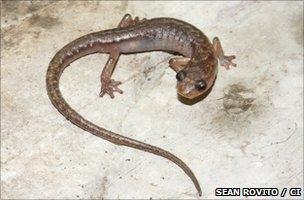'Lost' frogs found after decades
- Published

The Omaniundu reed frog was last seen in 1979, until the recent expedition
A mission aimed at rediscovering amphibian species thought to be extinct has yielded its first results.
Conservationists have turned up live specimens of two West African frogs and a cave-dwelling salamander from Mexico.
The salamander was last seen in 1941, and was rediscovered by abseiling into caves deep in the forest.
The expeditions are partially designed to bring attention to the plight of amphibians around the world, with a third of species at risk of extinction.
"It's pretty extraordinary to think about just how long it has been since these animals were last seen," observed project co-ordinator Robin Moore of Conservation International (CI).
"The last time that the Mexican salamander was seen, Glenn Miller was one of the world's biggest stars.
"The Omaniundu reed frog disappeared the year that Sony sold its first ever Walkman."
The expeditions, formally launched last month, collectively aim to find out whether 100 species thought extinct are in fact still alive.
The West African species - the Omaniundu reed frog (Hyperolius sankuruensis) from Democratic Republic of Congo, last seen in 1979, and the Mount Nimba reed frog (Hyperolius nimbae) from Ivory Coast, unknown since 1967 - are particularly intriguing, as both countries are subject to fairly intensive habitat loss.
As the human footprint expands, many amphibians are being pushed back into marginal areas, such as the Mexican cave system where the cave splayfoot salamander (Chiropterotriton mosaueri) turned up.
There had been no sightings of this salamander since its initial discovery in 1941.
It was thought to need humid caves, and conservationists feared it had been wiped out as the forests dried out after extensive logging.

Gaining access to the remaining cave splayfoot salamanders was not plain abseiling
"These are fantastic finds and could have important implications for people as well as for amphibians," said Dr Moore.
"We don't know whether study of these animals could provide new medicinal compounds - as other amphibians have - and at least one of these animals lives in an area that is important to protect as it provides drinking water to urban areas.
"But these rediscovered animals are the lucky ones - many other species we have been looking for have probably gone for good."
The re-discovery mission is scheduled to produce its final tally before October's summit of the UN Convention on Biological Diversity, to be held in Nagoya, Japan.
There, governments will discuss the human factors that are pushing many plant and animal species towards extinction, with amphibians in the vanguard.
Richard.Black-INTERNET@bbc.co.uk
- Published9 August 2010